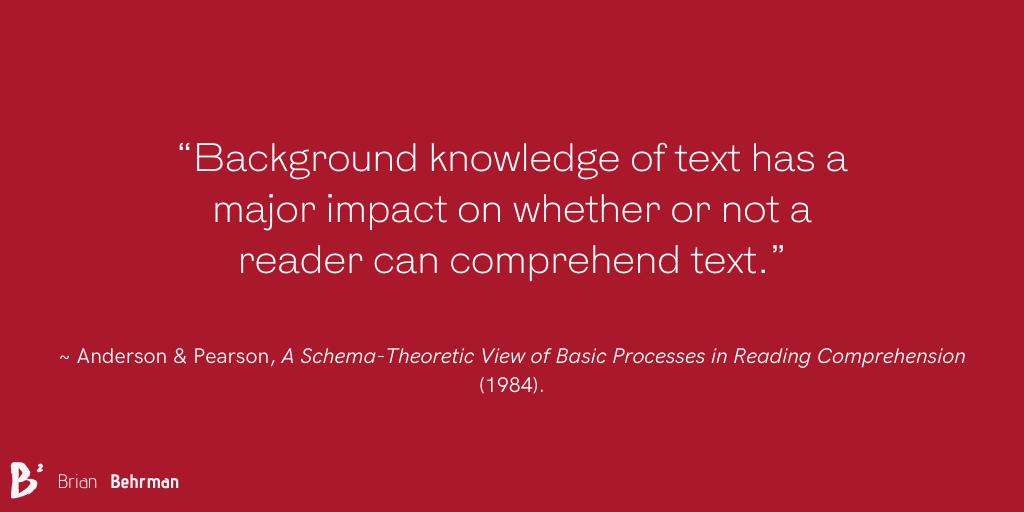In recent posts, I’ve really been focused on how we move our students from the stage of understanding phonemic awareness, phonics, and decoding across the bridge to reading comprehension. Ultimately, the purpose of reading revolves around understanding what it is that we read. That means helping to develop students who are fully literate – able to both read and write fluently. In part 1 (found here) I dug into the purpose of reading, some of the work from Anita Archer around the 4 things all students must be able to do in order to comprehend what they read, and then some ideas about how we make sure that our students are reading fluently.
In part 2 (found here) we looked at the importance of helping our students develop a wide vocabulary. One of the ways we do this is by teaching vocabulary explicitly. That post walks through what an explicit vocabulary routine might look like.
Today’s post is going to dig into the importance of adequate background knowledge. Let me share an example of how background knowledge impacted me recently. I consider myself to be a pretty fluent reader. When I run into vocabulary I don’t know, I have lots of tools to help fix that problem. But a few weeks ago, my daughter had a reading assignment for her biology class. She asked me to help her out a little bit. The article was a 4-page research piece on slime molds. As a former science teacher, I felt like this was something I could definitely help with.
Then I started reading. I clearly did not have enough background knowledge. I was able to read the article quickly, but I could not understand much of what was happening. I was lacking the necessary background knowledge to be able to truly comprehend what the article was saying. After sitting with the article for an hour, googling some terms, and doing some additional research, I was able to build enough schema to truly help my daughter with her assignment.
The moral to this is that even for our fluent readers, if they don’t have the appropriate background knowledge, they will not be able to comprehend the things that they have read.
But what does the research say about background knowledge?

While doing some research for this post, I read about a study that was done that took readers with a wide variety of reading abilities based on fluency and comprehension screeners. All readers read an article about baseball. No matter a student’s ability, the readers who already had background knowledge about baseball scored higher on the comprehension measures. Having background knowledge of the topic built a schema that impacted comprehension more than their reading ability.
With this knowledge in mind, Archer suggests there are some things we can do to be sure to build more background knowledge for our readers:
- Read informative read-alouds, especially in the primary grades, including a variety of books on similar topics to build a knowledge network.
- Directly teach science, social studies, and health.
- Promote wide independent reading
- Directly teach critical background knowledge before reading a passage
So, how might we go about directly teaching that critical background knowledge? Well, first of all, as the teacher, we have to be sure we have pre-read the passage. This allows us to identify key knowledge that our students will need to understand. A few of the things you want to be sure to call attention to might include:
- Is this a fiction or non-fiction piece?
- If there are characters, who are they? Introduce their identity and some basic information (gender, age, etc.).
- What is the setting? Describe the time and place. You might show the location on a map or globe, and then zoom in using something like Google Maps.
- This would also be an excellent time to include key vocabulary from the story. When teaching these words, if you can pull pictures that help build the background knowledge, that can support vocabulary development.
- If the setting is from a different period, do we need to provide some background knowledge about how people lived at that time?
- Finally, you might wrap up this section of building background knowledge with some retrieval practice. You might ask students “What are some things you have learned about…?” Since we want everyone to do everything, you might first have them write a few ideas down on a whiteboard or sheet of paper. Then you could partner students up and have them take turns sharing using the sentence stem “One thing I learned about…”
By helping our students build solid background knowledge prior to reading, we help set them up to be able to better comprehend the things they read. What are some of the ways that you go about helping to build background knowledge for your students? Share your methods and ideas in the comments below!
One thought on “The purpose of reading (part 3)”